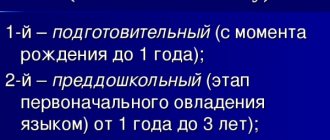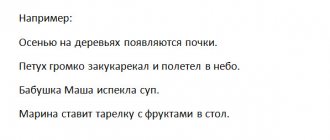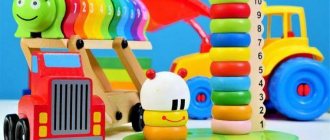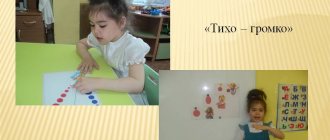The coherent speech of a preschooler is a significant indicator of his speech and general development. If a child reveals the meaning well in a conversation, logically and consistently talking about something, then adults note that he speaks coherently and coherently. At the same time, do not forget to note the mental development of the baby.
It is gratifying that the ability to speak meaningfully and understandably is developed through training. This means that parents and educators can help a preschooler get comfortable using their native language.
What kind of speech of a preschooler is called coherent?
The coherence of statements is not a randomly occurring characteristic. This is the result of the development of cognitive processes, enrichment of vocabulary and mastery of grammatical fundamentals.
Inspiration
The speech of a preschooler acquires coherence if it is filled with semantic content. And meaning appears only when sentences are constructed using appropriate words and taking into account the rules of grammar.
The first sentence is followed by the second, third... All together they reveal the content of the speaker’s thoughts or intentions.
A simple chain for an adult. But the preschooler has yet to learn to put the need to speak into understandable verbal forms.
Connected speech is a form of oral speech consisting of successive logical statements that reveal the content and meaning of a certain thought.
The development of coherent speech in preschool children is a qualitatively new stage. By learning to express his thoughts logically and consistently, a preschooler acquires the main new development in speech development.
Stages of formation of coherent speech in preschool age
The formation of speech - not only coherent, but also situational - in a child progresses in stages. Features of the speech development of preschool children are determined by the dominant type of thinking.
At 3-4 years old , a child develops visually effective thinking, and his speech practice is firmly tied to specific objects and situations. The younger preschooler already speaks, but in simple phrases using indefinite forms of pronouns and adverbs (that, there).
Read more about how speech development progresses in children 3-4 years old.
Coherent speech first appears in communication with adults and peers. An important condition for its formation is orientation towards the listener and the desire to speak in such a way that the listener understands.
No matter how small a preschooler is, he is faced with the task of acquiring the skills to clearly express the essence of what worries, interests, and worries him. Only in this way can the communicative function of speech be realized.
Signs of coherence appear due to the filling of the active vocabulary and the initial development of the grammatical structure of oral speech. Skills of free use of words are formed. Fragmentary statements are replaced by more detailed sentences.
There comes a period when we can distinguish two forms of coherent speech in preschoolers:
- contextual;
- explanatory.
By the age of 5, the child begins to compose complex sentences that sound like a set of simple ones. For example, five-year-old Katya enthusiastically describes what she just saw: “The duckling jumped into the water, then he swam, and the mother duck led all the ducklings to the shore.” In such statements, the grammatical structure of speech is already clearly manifested.
At this age, the preschooler describes visual situations well. He uses correct sentence structure and tries to present a complete picture of what he saw or heard about. In this case, the preschooler may “lose” the subject or predicate, but his speech is understandable in this context. Therefore, such speech is called coherent contextual.
A six-year-old child, in accordance with the norms of speech development, must actively use detailed statements and use linguistic means, such as comparisons and epithets. What most children cope with successfully. Their conversations are full of made-up stories.
Lenya says: “Look, I’m jumping like a bunny. It's my birthday, forest dwellers came to visit me and brought me a lot of delicious sweet carrots. And I will treat my guests to what they love.”
The coherent speech of children of senior preschool age is based on imaginative thinking. They imagine images and describe their characteristics, or remember events and give details. Older preschoolers use the most complex form of coherent speech - explanatory. Characteristic features are the logical unification of all parts of the message and the reflection of cause-and-effect relationships.
Development of lexical richness
Classes on speech development are best conducted using a playful method, giving the child the opportunity not only to gain useful knowledge, but also to have fun. You can invite a fairy-tale character to visit and ask your child all sorts of riddles. For example, today Mishka came to see us, it’s his friend Marten’s birthday today - let’s come up with as many kind words as possible for the birthday girl. The child tries to select various epithets that characterize the animal by color, appearance, character traits, and behavior.
Next, Mishka asks the following riddle - “Finish the sentences”:
- If the cat cannot find his house, we... (try to help him);
- If the flower has withered, then... (it needs to be watered);
- But the fox is bored, she... (needs to be cheered up). How are we going to make her happy? (Let's tell her a poem). Next, a poem is woven into the lesson, in which there are many words with a certain sound, the child’s task is to recite it expressively.
Now Mishka is wondering what the child was doing on the street yesterday. The child’s task is to compose a short coherent story about how he played in the sandbox or fed the pigeons.
It is important for parents to offer a topic for the story so that the child will be pleased to remember it. So, if yesterday another child broke his favorite toy, then it is better not to remind him of this event, but to offer to talk about something positive.
The bear should definitely thank the child for his efforts, but experts do not advise crushing a gift, even sweets, otherwise the baby may develop the habit of associating his work with a reward and not trying if there is none.
Dialogue and monologue in coherent speech of preschoolers
Language acquisition is realized through two main speech forms: dialogical and monologue.
Dialogical speech is primary in the development of a child. The children's vocabulary consists of a small number of words, and sentences have a simple structure. A preschooler learns to express a request to someone with whom he is working together, learns to answer questions, ask them and perceive the answers.
At first, for many children, even simple treatment seems overwhelming. The adult shows the child an example of how to make a request to a peer, and then encourages him to repeat it. To involve a preschooler in a dialogue, an adult asks him questions, asks him to talk about everyday events (where he was, what he saw, etc.). Thanks to the interlocutor's remarks, the little storyteller develops a coherent description.
Fascinating dialogue
As the child grows up, dialogues become longer and logically connected. When talking with a preschooler, an adult asks him about his impressions, about the qualities of objects or phenomena, trains the ability to give detailed answers, and observe the sequence of remarks. Older preschoolers use a similar practice in communicating with peers.
Monologue speech is a more voluminous and lengthy statement than a dialogue line. A monologue is subject to logic and expresses in detail the thought or opinion of one person. It can take the form of a story about some events. Can describe phenomena or objects. Often sounds like reasoning or persuasion.
The importance of monologue speech for a preschooler lies in the fact that the child learns to adhere to the chosen topic and logically structure his statement. In a monologue there is a “coherence of thoughts”, which ensures the coherence of speech.
Preschoolers begin to use monologue as soon as they become interested in the game. Girls like to talk edifyingly to their dolls, imagining educational moments. Boys can play with a car for a long time and at the same time voice their actions, talk with imaginary fellow travelers, traffic inspectors, etc. Such simple monologues contribute to the formation of coherent speech.
Norms for child speech development at 5-6 years old
Let's not forget that every preschooler is, first of all, an individual who develops according to his own laws, so what is easy and accessible for one child may still pose insurmountable difficulties for another. However, experts have identified certain speech skills that children who have reached this age should already possess.
- Correct pronunciation of all sounds.
- Speech should be coherent - an older preschooler should be able to describe the picture shown to him, using complex common constructions, talk about how his day went, what he did, what emotions he experienced. The narrative should be understandable to the listener and consist of a number of consistent sentences.
- By the age of 6, a child knows a large number of words and actively uses synonyms and antonyms. Vocabulary – 3000 words or more.
- Not only concrete words appear in speech, but also abstract ones. The child understands what a “general word” is and can say that rose, peony and daffodil are garden flowers, and cornflower and chamomile are wildflowers; explains why. The development of speech skills is closely related to the knowledge of the world.
- Various intonations are actively used, the child can “speak in different voices” during the game, giving each game character his own speech style.
It is during this period that inner speech is formed, which will later help the child both in school and in adult life. Also, the baby must be able to determine by ear the number of syllables in a word, understand which of them is stressed, and distinguish between soft and hard versions of consonant sounds. It is also important that the preschooler be able to understand whether there is any specific sound in a particular word and determine this by ear. Some grammatical errors are acceptable (for example, saying “towels” instead of “towels”).
A harmoniously developing preschooler will retell the text without any problems and will be able to answer questions about it.
Techniques for developing coherent speech in preschoolers
A growing child develops internal motives to master their native language better and more deeply. The preschooler is interested in many things, and there is a desire to ask and tell more. There is a need to influence the interlocutor, express your opinion, argue.
This means that the relevance of the development of coherent speech in preschoolers is supported by favorable conditions - an adult offers to help the child learn to speak logically and clearly, to which he receives a lively response.
There are proven methods and techniques that stimulate the speech development of preschool children. These include:
- retelling;
- stories based on pictures;
- writing fairy tales and stories.
Teaching preschoolers retelling
It would seem that retelling is the simplest speech training. You don’t need to invent anything, just remember what the text says and convey it in your own words. But a preschooler doesn’t have that many words in stock!
We read, we retell...
Children's literature is written in accessible language, but necessarily covers the child's vocabulary. Therefore, in order to convey content, children, along with known words, need to use new concepts.
It is even more difficult to adhere to the course of events presented in the plot. A preschooler is required to be able to comprehend what and how is happening to the main characters in order to tell everything coherently.
It is convenient to solve the problem of how to teach a child to retell a text in the following sequence:
- Read an interesting story or fairy tale.
- Clarify the child’s impressions (whether he liked it or not, what characters or events interested him).
- Pay attention to new concepts and talk about them together.
- Invite the preschooler to tell this fairy tale, story (present in a playful way, and not as a retelling task).
- “Do you remember how it all began?” - read the first lines. Typically, the little listener will soon interrupt and begin to convey the content.
- The adult constantly supports the narrator, encourages him to continue with hints: “What happened next?”, “Where did they go?”, “What was it like at that time?”, etc.
- Having completed the retelling, praise the child and pay attention to the moral that is necessarily contained in children's stories: whether this or that hero did well.
The proposed procedure for teaching retelling should be applied when the formation of coherent speech in preschool children is just beginning. Older preschoolers can master independent retellings if they first make a plan of what the story will be about. To tell a story according to plan, it is necessary to highlight several key events in the overall storyline.
Development of coherent speech based on pictures
The skill of coherent statements using visual material is successfully trained. These can be single pictures, as well as a series of images that reflect the development of the plot.
The preschooler is asked to tell:
- What is shown in the picture.
- What events happened before?
- How will the situation develop further?
When using pictures, it should be taken into account that older preschoolers enthusiastically fantasize and use detailed explanations based on images. But the presence of pictures increases the situational nature of speech in younger preschoolers - instead of describing, they can point to the details depicted.
Troubleshooting Defects
Preschoolers aged 5-6 years may have difficulty pronouncing the sounds [l] and [r], as well as other problems that parents need to solve together with specialists, asking the child to perform tasks from speech therapy: breathing and articulation exercises, pronouncing pure words, in which words with problematic sounds are presented. Also, defectologists advise performing various exercises.
"Fruits"
You can play anywhere, while walking or at home. The adult shows the child a series of cards depicting fruits and asks them to name them. If the lesson is held outdoors, cards are not required; you can simply ask them to list familiar fruits.
Next, the adult asks questions.
- What is the name of apple juice? (Apple). And from peach, orange? This exercise helps to develop the ability to form words independently.
- Now imagine that all these fruits belong to you. What do you say? (my apple, my tangerine). Children learn to correctly agree between pronouns and nouns.
- Let's compose a story about fruit according to plan: color - shape - taste. Describe an apple.
You can also draw at home. The mother draws one fruit, for example an orange, asks the child to draw several and name the drawing correctly, thus recognizing the concepts of “one and many.” Next, he asks to draw a large orange and a small one, helping the child understand these categories and subsequently use them in speech.
Forming coherent speech by writing stories
Essays develop imagery, logic, and expressiveness of statements. By writing stories we mean any stories told by a preschooler.
The more vocabulary a child has, the easier it is for him to express his impressions and fantasies. The finished story contains a number of supporting points, which preschoolers are guided by in the retelling, and in the stories they compose, they freely build all the plot twists.
Story-writing skills begin to develop when the child is asked to describe what he saw on a walk, in the park, or on the playground. Middle-aged and older preschoolers willingly tell episodes from their lives - where they visited, with whom and how they spent time.
The development of coherent speech in preschool children occurs not only in specially organized conditions, when the child is asked to retell, describe, or invent. Every day, in communication and play, children use contextual and explanatory speech, replenish their vocabulary, which increases their speech level.







